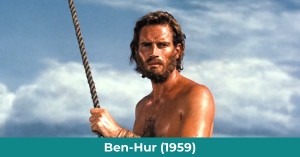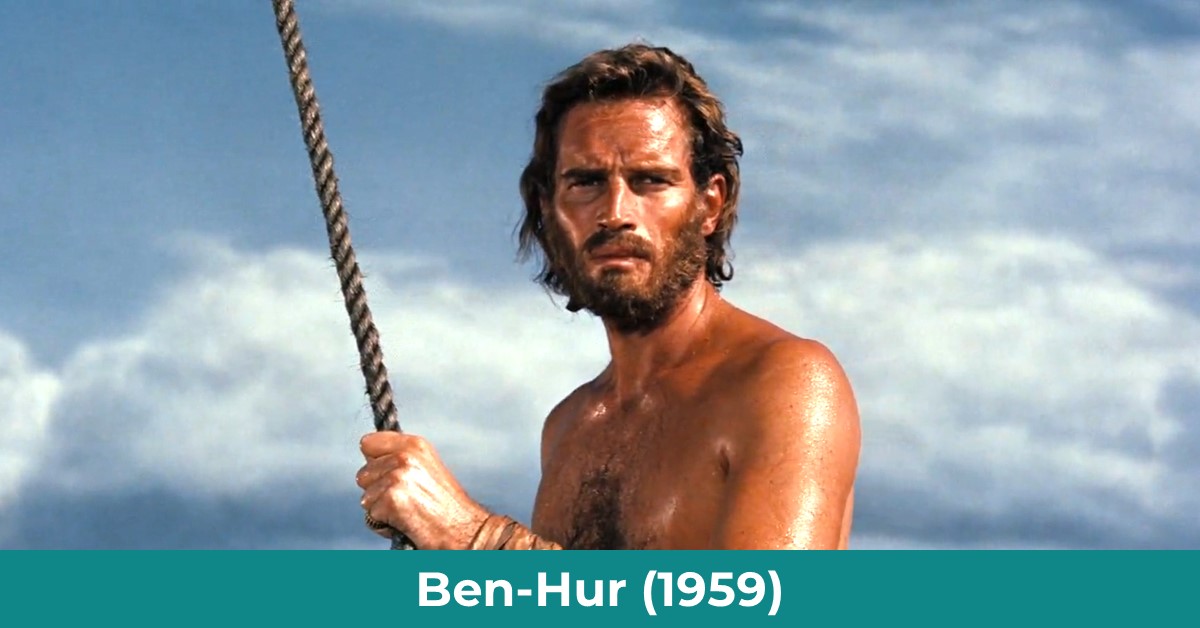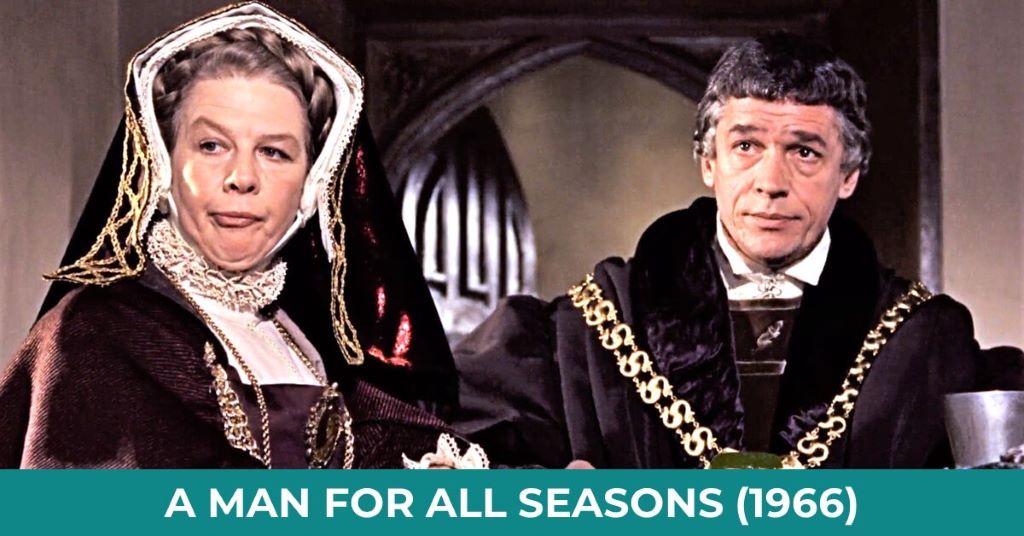Last updated on December 10th, 2023 at 11:01 am
Ben-Hur 1959 film is an epic religious powerful drama that powerfully showcases the Spiritual ability of Jesus Christ in his sacrifice on the cross that took place during the time of Tiberius Augustus Caesar, the second emperor of Rome.
The film additionally shows the enmity between two childhood friends, Judah Ben-Hur, a wealthy young Jewish prince in Jerusalem, and Messala, a Roman who became a Roman tribune in Judea while Ben-Hur remained focused on freeing the Jewish community from Roman oppression.
Directed by William Wyler, Ben-Hur is based on Ben-Hur: A Tale of the Christ (1880). It is one of the best-selling novels of all time, by American writer, military leader, and statesman Lew Wallace, is an adventure story set during the Roman Empire. The novel follows Judah Ben-Hur, a Jewish man from a prosperous family, and integrates events from the life of Jesus Christ. Near the start of the novel, the Hur family fortune is confiscated and Ben-Hur is sold into slavery, all chiefly because of a former friend, a Roman named Messala. Set on revenge, Ben-Hur enters a chariot race against Messala.
The two friends became enemies when Messala returned to Judea after a long separation as a Roman tribune, a defender of the rights of the people of Rome, and Ben-Hur refused to cooperate with him to consolidate his reign in Judea.
In fact, Ben-Hur refused to cooperate with the Roman empire by betraying his Jewish community even when his sister, Tirzah, developed an affection toward Messala, a refusal for which Judah had to pay a high price.
Although William Wyler keeps up consistent pressure, it is inevitable that there should be two or three “set” pieces, and among them are the sea battle and a chariot race. The race is a fantastically tough affair, magnificently conceived and photographed, and will be memorable in the history of the cinema. But then this Ben-Hur is something of a historic landmark itself, even if it leaves the spectator with the sense that he has been in the ring for 10 rounds with a heavyweight champion.
Moreover, its 2016 version tells Ben-Hur’s story differently and romantically.
It focuses on how the life of peace-loving, kind and family-loving wealthy Jewish prince Judah turned warrior to seek revenge on his adoptive Roman brother Messalla for enslaving him and imprisoning his family became merciful by being influenced by the teaching of Jesus Christ.
Snippet
- Film name: Ben-Hur
- Release: 1959
- Runtime: 3hs 52 minutes
- Cast: Charlton Heston, Jack Hawkins, Haya Harareet
- Director: William Wyler
- Based on: Ben-Hur: a Tale of the Christ by Lew Wallace
- Academy Awards: 11
- Genre: History, Religion, War, Drama
- Ratings: YST 8.1/10, IMBb 8.1/10 stars.
Ben-Hur 1959 film storyline
The story begins as the Roman Empire passed a decree ordering the Judeans to return to their place of birth for census and taxation during the seventh year of Tiberius Caesar Augustus in AD 21st or 26th.
People, crowded in Jerusalem around the Fortress of Antonia and the great Golden Temple started leaving for their respective native areas. Among them were a couple, Mary and Joseph.
Mary, Joseph’s wife, gave birth to a child on their way to Nazareth and three astrologers came to visit the child with gifts. As the boy was growing up, Judah Ben-Hur got into trouble during the visit of the Governor of Judea, Valerius Gratus. Gratus had been accompanied by Messala and other Roman officials. Valerius Gratus was hurt by a loose tile that fell from the roof of Judah’s house while passing by. Tirzah unintentionally caused the falling of the tile of the roof while onlooking the procession.
His mother, Miriam and sister and he were arrested for plotting to murder the Governor.
Though Messala knew that it was just an accident, he still enslaved him and sent him into galleys while his mother and sister were imprisoned just because of Judah’s opposition to Messala.
Messala refused to release them without a promise of helping him from Judah. While being taken to galleys, the official rested for water in Nazareth. But when only Judah was refused a drink, a man, Jesus came forward and offered his water.
But before the arrest, Judah fell in love with Esther, a daughter of their servant, Simonides who brought her to him to be released to be married. However, seeing each other after a prolonged separation they fell in love with each other. During his captivity, as a galley slave, Judah oared alongside other Roman slaves drawing Roman Consul Quintus Arrius’s attention. But one day, during the battle against Macedonian pirates, Arrius decided to keep Judah unchained. When Quintus Arrius was hit and fell into the ocean, Judah came to his rescue and prevented him from his possible suicide.
In Rome, while presented to the Roman Emperor, Judah was granted freedom and was given to Arrius as a servant for his use.
But Arrius, having no sons, in turn, made Judah his heir and thought of making the governor of Judea after Valerius Gratus, who was eventually replaced by Pontius Pilate, a friend of Arrius.
Judah returned to Judea, after four years, to his abandoned home and inquired about his mother and sister from Messala telling him that he will be forgiven of all wrongs only if he was able to return to his mother and sister. But when the officials found out that his mother and sister had contracted leprosy, they were released and sent to the Valley of Lepers, a designated area for people with leprosy. Judah was surprised to find Esther unmarried, waiting for his return.
One night Miriam and Tirzah visited their home and were found by Esther.
Miriam urged her not to tell Judah about their condition with leprosy, even though Esther maintain contact with them and provided them with food in the valley. Esther to Judah that they were dead.
In the meantime, Sheik Ilderim, A mighty man from the Desert, somewhere beyond Moab, and owner of camels in herds, and horses descended from the racers of the first Pharaoh, visited Messala and told him that he wanted to race his white horses against his magnificent, noble and undefeated blacks for a thousand talents, which his people were praying for a victory over arrogant Messala. Sheik said the driver of his chariot would be Ben-Hur. Messala agreed. Sheik provided the training and horses to Judah.
Pontius Pilate inaugurated the game. At the great shock of Pontius Pilate, Judah came out as a winner against the racers from Alexandria, Messina, Carthage, Cyprus, Rome, Corinth, Athens, Phrygia and Judea making Masala half-dead. Right after his victory, Judah visited Masala while struggling with his life. Masala revealed to Judah that his mother and sister were in the Stone Valley, the leper colony.
One day Judah followed the stone valley and was shocked to see his wife, Esther, carrying food for them.
Esther told him that he must not see them.
Judah was sent for to Jerusalem and offered Roman citizenship by Pilate which he refused because of the way Rome treated his family and his people. He returned the ring but was commanded to leave Judea. Esther told him about a man who is more than a man, Jesus Christ. She told him about Jesus’ sermon on the mount. He could not believe that the merciful would be called the children of God. He only believed in freeing and cleaning the people of Judea of the tyranny of Rome by blood and revenge.
But Esther objected to his intent of blood revenge by saying, I know there is a law in life.
That blood begets more blood as a dog begets a dog. Death generates death as the vulture breeds the vulture. But the voice I heard today on the hill said: “Love your enemy. Do good to those who despitefully use you. You seem to be now the very thing you set out to destroy giving evil for evil. Hatred is turning you to stone. It’s as though you had become Messala”.
Judah and Esther returned to the valley of lepers and carried them out in the hope of seeing them to Jesus who was being tried by Pontius Pilate in Judea.
They carried them through the crowd in spite of people’s indignation. But Miriam and Tirzah who tried hard to get close to him were miraculously healed of their Leprosy as Jesus was crucified.
Ben-Hur 2016
Unable to bear Naomi’s, Judah’s mother, discriminatory behaviour, Judah left Jerusalem for Rome to fight for Rome against Germania where he was saved by Pontius Pilate and made a leader.
Before returning to Jerusalem after three years as a Roman tribune, Messala led many battles. Messala wanted Judah’s cooperation in controlling the zealots who were revolting against the Roman Empire to free the Holy Land during Pontius Pilates’ parade. But things turned against Hur’s family as Dismus, whom Judah saved from Romans and sheltered and Zealot, shot an arrow at Pilate. In order to save Dismus, Judah confessed to the crime he did not commit.
Arrested, he was sent to galleys as a slave, while his mother and sister were sent to prison by Messala.
Judah washed ashore as the lone survivor of the entire Roman fleet in the battle against the Greek pirates.
Judah was saved by Ilderim, an African trader, who wanted him to return him to the Romans, which Judah did not expect. Ilderim conditioned Judah that he may to return him only if he does horse chariot race for him against Messala in the circus. If he survives, he will be praised instead of being condemned.
Judah agreed to race.
Ilderim provided the training, tactics and his white horses. Pilate inaugurated the game and Judah won the game making Messala injured. Messala asked for fear that he might be killed by Judah while he was visited after the game.
But instead of killing, Judah forgave Messala and got united as brothers as in the old times.
Awards
With the largest budget of 15.2 million dollars and 146.9 million dollars of box office business, Ben-Hur bagged 11 Academy Awards and won three Golden Globe Awards, a Special Achievement Award, the BAFTA Award for Best Film, the New York Film Critics Circle Award for Best Film.
It is one of the best films of the American Film Institute. It is one of the 101 best films of 100 years that I have been reviewing.
Directed by William Wyler and starring Charlton Heston, Jack Hawkins, Haya Harareet, and Stephen Boyd, Ben-Hur 1959 is an American epic religious film is a remake of the 1925 silent film of the same title and was adapted from Lew Wallace’s 1880 novel Ben-Hur: A Tale of the Christ.
In 2004, The National Film Preservation Board selected Ben-Hur for preservation by the National Film Registry for being a “culturally, historically, or aesthetically significant” motion picture in 2004. Ben-Hur had been listed as number 491 on the British film magazine Empire’s 500 Greatest Films of all time.
Themes and Messages
Ben-Hur is first and foremost a film that attracts and holds the eye.
Lew Wallace wrote a story that was a story in the full sense of the word, and Mr. Wyler keeps the lines of the narrative stretched and clear throughout the nearly four hours the film takes to run. Ben-Hur, although the screen too often consists of little save his face, succeeds in giving the impression of a man who is thinking even when he is involved in violent action and who develops under the stresses and strains of calamity. Ben-Hur’s Judah showed us the triumph of relations and family bonds.
After all the ordeal and the unexpected torture at the hand of Roman authority, he never faltered his ideals as a Jew and had always been concerned about his mother and sister, and the oppression of Rome towards the Jewish community.
The trials and tribulations faced by Judah Ben-Hur resonate with audiences, reminding them of the universal experiences of love, loss, and personal transformation.
Judah could easily have complied with the Roman authority had he sought power and fame. Moreover, he refused to hold on to the privilege he had through the adoption right. All he cared and was concerned about was the freedom of his people and the end of the tyranny of the Roman Empire. When the lepers were considered outcasts and untouchable, Judah refused to bask on the fact that they must be avoided any physical contact with them who are bound to die in the segregated valley of death.
He fearlessly found them out and brought them out of the valley of death and brought them to a doctor who heals miraculously by healing one’s spirit.
Ben-Hur explores a number of themes that reverberate with audiences to this day. Revenge, forgiveness, and redemption are central themes throughout the account. The film highlights the destructive nature of vengeance and the transformative power of forgiveness, emphasizing the importance of letting go of hatred and embracing compassion which Judah followed through the teaching of Jesus Christ. Moreover, the story delves into questions of faith and spirituality. The encounters between Judah Ben-Hur and Jesus Christ serve as catalysts for his spiritual journey. The movie encourages viewers to reflect on their own beliefs and the significance of faith in their lives.
At its core, Ben-Hur is a reflection on the human struggle in maintaining their calling and passion in their lives. It portrays the resilience of the human spirit in the face of adversity and the capacity for growth and change. The character of Charlton Heston as Judah was marvellous as was of Stephen Boyd as Messala who chose to die without being operated instead of presenting a mutilated half body to Judah. Haya Harareet’s character as Esther
Just want to finish with what Pontius Pilate conveyed to Judah at his palace when Judah complained about Messala’s mistreatment of his family.
“Where there is greatness”, said Pilate, “great government or power, even great feeling or compassion, the error also is great. We progress and mature by fault.”
Whether oppression, injustice or mistreatment of minorities or oppositions can be justified by the death of the oppressors is the question I left to the proponents and opponents of the oppression.
Conclusion
Ben-Hur remains an unparalleled cinematic achievement, weaving together a compelling narrative, breathtaking visuals, and powerful performances. Its timeless themes of revenge, forgiveness, and redemption continue to resonate with audiences, reminding us of the transformative power of compassion and faith.
Ben-Hur 1959

9






